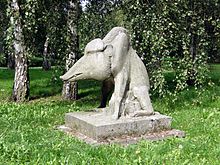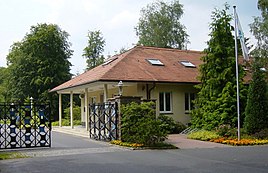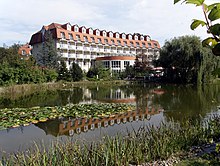Waldsiedlung (Bernau near Berlin)
|
Forest settlement
City of Bernau near Berlin
Coordinates: 52 ° 44 ′ 3 ″ N , 13 ° 29 ′ 11 ″ E
|
|
|---|---|
| Height : | 70 m |
| Area : | 1.5 km² |
| Incorporation : | July 1, 2001 |
| Postal code : | 16321 |
| Area code : | 033397 |
|
Main entrance / guard to the former "inner ring" of the forest settlement (photo: July 2004)
|
|
The Waldsiedlung in Bernau near Berlin is a one-and-a-half square kilometer housing estate that became known as a closed settlement for the members and candidates of the Politburo of the SED Central Committee . The complex, which was built in 1958, is often referred to as the Waldsiedlung Wandlitz (or Wandlitz colloquially for short ) due to its proximity to the village of Wandlitz , but is not located in the area of the village of the same name. After the fall of the Wall , the guarded area was opened, redesigned and, to a large extent, rebuilt. It is located in the area of the city of Bernau and has been designated as the city's residential area since 2001 . In June 2017, the Brandenburg state government placed the historic buildings on the estate under monument protection.
history
Construction and reference
The settlement was built from 1958 to 1960 by decision of the SED Politburo in the middle of a forest area that was known to the local population as a shooting range . The completed settlement, which was not shown on any map, was initially occupied by 23 politicians with their families and was subordinate to the Personal Protection Department of the Ministry for State Security (MfS). The members of the Politburo could be better secured there than in their villas on Majakowskiring in Berlin-Niederschönhausen . Moving their residence to the Waldsiedlung was compulsory for members working in Berlin when they were appointed to the Politburo.
Fuse
The shielding was not immediately visible from the outside. The outer ring was lined with a chain-link fence with signs indicating a wildlife research area. The inner ring, which was only partially enclosed by the outer ring, was surrounded by a two-meter-high and five-kilometer-long green painted concrete security wall and was only allowed to be entered with a special ID. The area with its four gates was secured by the "Feliks Dzierzynski" guard regiment . In addition, the PS guard (main department for personal protection) was deployed. In total, the security area consisted of 33 guard areas, including guard areas 32 ( Liepnitzsee bathing area ) and 33 ( Haus am See - summer house of the Soviet embassy ). Two posts were housed in watchtowers in front. The guard was referred to as "military operational security service", under duty with "MOS". The security personnel comprised around 140 people.
The security guards had a mushroom-shaped shelter with an explosion-proof telephone known from mining. In addition to the guards, the gates were also monitored by video. The green wall was illuminated with a fluorescent lamp about every 30 meters at night. In case of fog, a second upward glowing one was switched on. In some sections signal systems were attached to the wall. The posts were each on duty for over 24 hours and were replaced four times during this time.
Life in the settlement between 1960 and 1990
The first residents moved into the forest settlement in the summer of 1960. In the inner ring it initially consisted of 21 one and two-story detached houses with partly 7 and partly 15 rooms, the latter with up to 180 square meters of floor space, a clubhouse with a doctor's office , swimming pool , sauna , cinema and restaurant , a hunting and handgun shooting range and a sports field with tennis facilities . In the so-called outer ring (which only partially enclosed the inner ring) there was, among other things, a nursery , a polyclinic as well as residential and social buildings for employees and security personnel. The functionaries of the SED Politburo lived in the settlement on a very high level by GDR standards. About one as charging Combine designated sales facility reached the residents and their families to enjoy high-quality DDR and West products and an exceptional offer of fresh fruit and vegetables. Almost every purchase request, including ordering via catalog and shopping in West Berlin , could be fulfilled. The Letex Sector of the Commercial Coordination was responsible for this . As during changes in November 1989, the mission team 99 of the GDR television the relative luxury of Wandlitz showed this contributed to the anger of the population about the regime, while at this time the range of the charging Combine was significantly reduced.
A staff of over 60 domestic workers (all MfS employees with military rank) took care of all aspects of daily life, a total of 650 servants were employed in the settlement. The members of the party and state leadership enjoyed a lifestyle in the forest settlement that was far above that of a normal GDR citizen. This and the isolation from the own population contributed to the alienation between the leadership and the people and were repeatedly and sharply criticized during the turnaround, but also before.
Former residents of the forest settlement
|
|
Dissolution of the politicians' estate and subsequent use
In 1989 the residents had to leave the settlement by decision of the GDR government under Prime Minister Hans Modrow . In 1990 the Brandenburg Clinic Bernau was built as the first large rehabilitation center in the new federal states on the grounds of the forest settlement. On the day of reunification on October 3, 1990, a comprehensive construction and renovation program began.
In addition to the rehabilitation clinics and other newly built facilities, the former residential buildings were rented out. A large number of new residential buildings have been added. A completely laid out extended path system with the main axes Brandenburgallee (west-east direction) and Kurallee (north-south direction) opens up the Bernau district.
Life in the forest settlement after 1990
Health and Commerce
From 1990 the houses in the forest settlement were gradually converted into medical and care facilities under the direction of the former Deputy Minister for Health of the GDR, Ulrich Schneidewind . As of December 2011, the following are available on the site:
- the Michels-Kliniken company with the Brandenburgklinik complex (Brandenburgallee 1). This clinic is home to specialist departments for neurology in treatment phases B (75 acute beds in the state's hospital requirements plan), C and D, psychosomatic medicine, as well as orthopedics and cardiology. With a total capacity of 700 inpatients, the Brandenburgklinik is the largest facility in the Michels Kliniken group. The individual departments are spread across several hospitals as follows: Clinic I, House Brandenburg , Clinic II, House Barnim , Clinic IV, House Havelland , Clinic V, House Potsdam (since October 2013, previously Parkklinik , Clinic VI, House Berlin .
- The children's aftercare clinic Berlin-Brandenburg is a non-profit, family-oriented rehabilitation clinic for children and adolescents with heart and cancer with 100 beds. It is looked after by “Carpe diem”, a support association for children with cancer.
- All clinics have around 1000 beds.
- the vegetative coma center in the Regine-Hildebrandt-Haus
- the senior center Haus Birkenhof for 99 residents (Johann-Strauss-Str. 2)
- the senior citizens' residence Lindenhof (opened in 2003; Offenbachstrasse 150), a residential complex with a total of 65 two or three-room apartments
In addition, companies such as Möbel-Wolf (warehouse, shipping company, factory outlet), a grocery chain or a nursery have settled in some existing or newly built halls.
Living area
A network of eleven streets in west-east and three streets in north-south opens up the site. For the residents there are service providers such as hairdressers, cosmetics, tailors, medical practices, restaurants and snack bars. A special school for the mentally handicapped and a Montessori school complete the offer.
Art in the settlement

After the completion of the development, numerous works of art were erected on the site. There was also a commission that made a selection from existing sculptures. Around 13 bronze figures were then set up in front of communal facilities such as the swimming pool, the sports field or the sales facility and in house gardens, for example the resting dancer by Waldemar Grzimek at Günter Schabowski's house , a standing nude by Lore Plietzsch in the garden by Werner Krolikowski . Other figures and works of art, also made of sandstone, by well-known artists such as Walter Arnold or Gerhard Geyer , a terracotta picture and a mosaic by the sculptor Ingeborg Hunzinger , plaster ceramics by Heidi Manthey and ironwork on fences and gates also adorned the extensive complex.
Some of the works of art were stolen after 1990 or moved to new locations when the site was converted into a clinic. In the spring of 2010, more sculptures disappeared, which was declared by those responsible at the clinic and the head of culture for the city of Bernau with the securing and professional renovation. In autumn 2011, of the sculptures, only Waldemar Grzimek's boar and the wrought-iron main gate attributed to Fritz Kühn were left in the area. Five of the missing sculptures have since been recovered; they had appeared in private gardens and in art dealers, and one was even found in a landfill.
The Bernauer Kulturamt has put the sculptures together in an exhibition in their “Art Space Downtown” and is also offering an exhibition volume with artist biographies, a short retrospective and historical background. Entry is free.
Transport links
The forest settlement is located on the federal road 273 between Wandlitz and Bernau. The Wandlitz motorway junction on the A 11 Berlin– Stettin is about three kilometers away. On the occasion of a major road renovation program in the 2010s, due to major damage to the concrete surface, the entire section of the B 273 was dismantled and paved with one lane in each direction.
The current residents of the settlement as well as the patients and guests of the clinic facilities can use a bus connection (line 894) of the Barnimer Busgesellschaft (BBG) set up in the early 2000s . It enables connections to the S-Bahn and regional trains in Bernau or to the Heidekrautbahn in Wandlitz.
literature
- Klaus Bossig: GDR tour while traveling. Rail, road, air and water vehicles for state trips by the GDR leadership. EK, Freiburg 2010, ISBN 978-3-88255-734-3 .
- Jürgen Danyel, Elke Kimmel: Waldsiedlung Wandlitz: A landscape of power. Ch.links, Berlin 2016, ISBN 978-3-86153-876-9 .
- Elke Kimmel, Claudia Schmid-Rathjen: Waldsiedlung Wandlitz: A region and the state power (= places of history. ). Ch.links, Berlin 2016, ISBN 978-3-86153-905-6 .
- Paul Bergner: The forest settlement. A non-fiction book about »Wandlitz«. 6th expanded edition. FB-Verlag, Basdorf 2016.
- The forest settlement - who lived where? FB-Verlag, Basdorf (Brochure 20 pages, Book Description ).
- Later protection for a DENK time. The Waldsiedlung , 2017 FB-Verlag Basdorf, 36 pages.
Web links
- Entry in the monument database of the State of Brandenburg
- Jan Carpentier : Honecker's elite settlement. Shock report in the Bonzenviertel. , Article in einestages from Oct. 22, 2009 (about the turning report from 1989 for the youth program Elf 99 - the film was shown on GDR television on November 23, 1989; with 17 photographs; introduction: ... legendary Wandlitz report about the mysterious housing estate of the GDR elite ... )
- Description of the exhibition "Inner City Art Space - Sculpture Collection of the Bernau Forest Estate"
- From the secret Waldsiedlung Wandlitz ... to the recreation and health resort on www.waldsiedlung-wandlitz.de.
- The bunker systems in the Waldsiedlung at www.untergrund-brandenburg.de.
Individual evidence
- ↑ a b c Jens Blankennagel: Ulbricht's house is a listed building. The Waldsiedlung, the home of the SED Politburo, is now officially a historically valuable place. In: Berliner Zeitung , 17./18. June 2017, p. 16. (print edition). (online: [1] ).
- ↑ Andreas Malycha: The SED in the Honecker era. De Gruyter Oldenbourg, Berlin 2014, p. 21
- ↑ Source: Paul Bergner: Die Waldsiedlung , page 273.
- ↑ Detail from the Chronicle of the Wende from the rbb (online), accessed on December 19, 2011.
- ↑ Brandenburg Clinic
- ↑ Brandenburgklinik website with a reference to the renaming , accessed on August 31, 2014.
- ^ Website of the children's aftercare clinic
- ↑ Website with information on the vegetative coma center
- ↑ Website with information on the Birkenhof senior center
- ^ Website of the Lindenhof senior citizens' residence
- ↑ Andreas Fritsche: Renovation in the forest settlement without hands and feet. The bronze sculptures have been removed from the former house gardens of the SED Politburo members. New Germany from April 7, 2010
- ↑ Watching naked women. The sculpture collection of the Bernau forest settlement is visited in large numbers. In: Märkischer Sonntag from 6./7. July 2013, p. 7.
- ↑ bus line 894 with all stops; here: Bernau Brandenburg Clinic ; accessed December 10, 2017.





